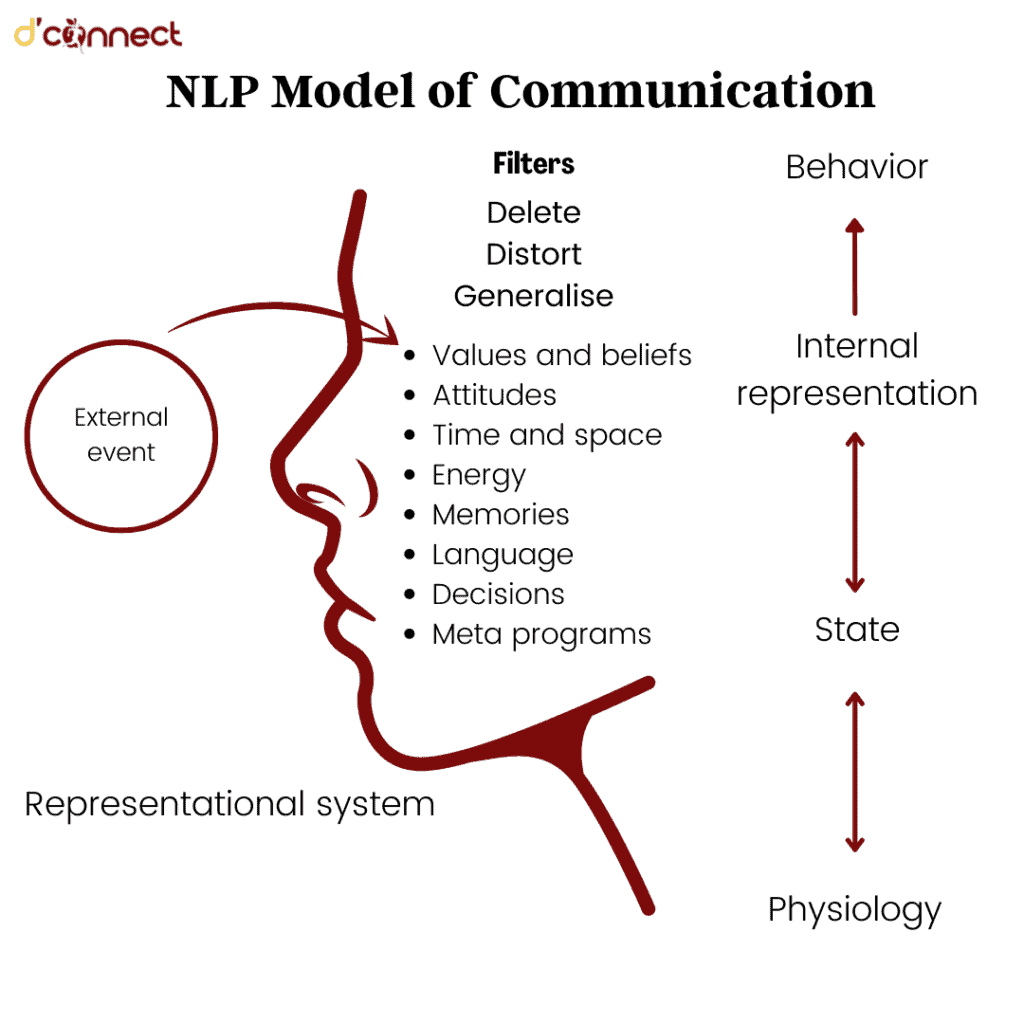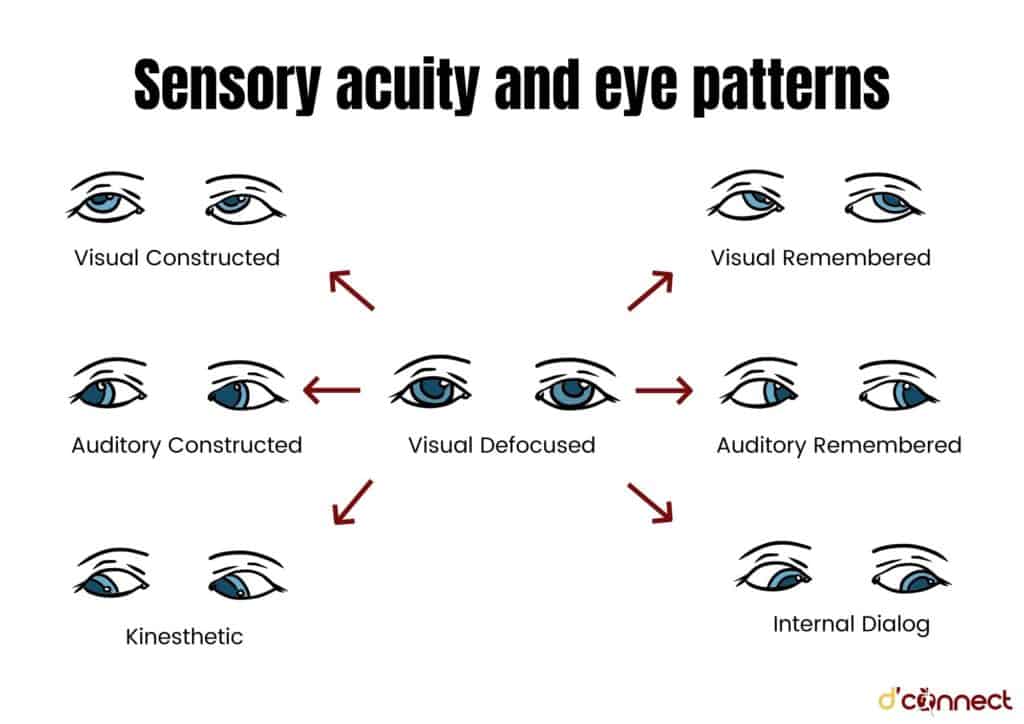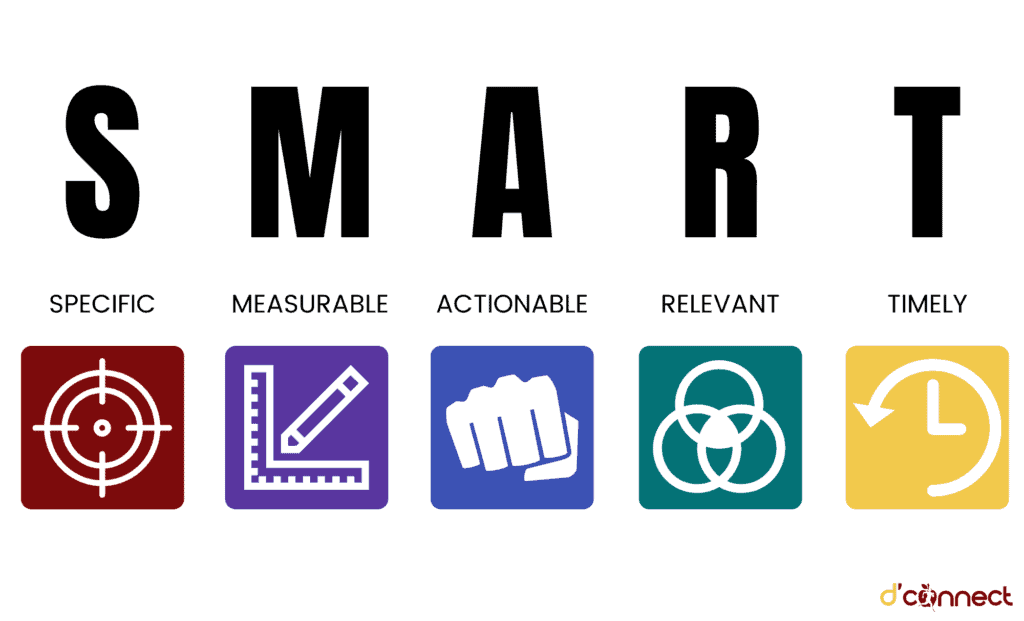
Christine Walter
Hypnotherapist, Life Coach, mBit Master Coach and NLP Master Practitioner
Note — The article was checked and updated June 2023.
Neuro-linguistic programming has been developing extensively over the last few decades, which has contributed to a growing number of techniques and methods, some more successful than others.
In this article, we will talk in more detail about Neuro-Linguistic Programming Key Methods and Techniques such as:
- Presupposition
- Model of Communication
- Prime directives of unconscious mind
- Sensory acuity and eye patterns
- Rapport
- Well Formed Outcomes
- Chunking
But first, let’s start with the basics, and explain the foundations of NLP terminology.
Neuro-Linguistic Programming Terminology
The best way to understand Neuro-Linguistic Programming would be to undertake an NLP Practitioner course. Before we can start with techniques and methods, the course provides an introduction to how NLP was created and what it is, and also shares more information about important terminology to learn.
Content and Context
To an NLP Practitioner it is important to understand the difference between “content” and “context” in a conversation. Being able to discern between these can direct the conversation and more efficiently obtain the deeper structure of the event or meaning being put on the event.
Content
All words used in discussion are content. It is impossible to have context, form, process and pattern without having content.
Context
Context refers to the positioning of the content, storyline or purpose that provides value to the listener. In NLP we want to understand what needs to occur to trigger a behaviour – this is context. We also listen to where emphasis is placed in the language to get a gist of what is going in.
Congruence
Astate of being fully aligned and fully sincere within a person to enable creating the desired outcome.
Ecology
Relating to personal internal ecology as well as external ecology, this refers to being concerned for the overall relational links between being and the environment. Thoughts create behaviour which create outcomes – at all levels what is the “knock on effect” of these. Considering ecology creates space to consider the bigger picture that one thing will impact.
Form
Form refers to that which shares commonality to be able to operate the process.
Process
Process refers to the “how” when observing or discussing something. Consider a process to be a one-off event of the “how” that can lead to patterns. For example, we may clean our teeth in a particular way for the outcome we want to achieve. Not everyone will have the same process to complete this task.
Pattern
In brief, a consistent process that creates the “how” is a pattern. For example, all NLP techniques or processes can be referred to as patterns e.g. SWISH pattern.
Logical Level
Many aspects of our world have different levels. A logical level is an understanding that a higher level incorporates the level below it. A logical level is the logical inclusion of what is being discussed or compared.
For example, to discuss different types of cups we discuss at a logical level. If that conversation were to change to all vessels that can contain water, we have lowered the level to include much more. To take the conversation to a higher level we might consider all manner of cups with handles.
Logical Types
Logical types consider things that are of similar form and characteristic. In the example above we might discuss all manner of tea cups with handles. There is a specific comparable type to this level of conversation.
Meta
Meta is another word that is commonly used in NLP. Derived from Greek meaning “over and beyond” NLP refers to meta-states, meta-model, and “going meta”. It means to go beyond the current state/space/self. For example, to ask oneself “how do I feel about this feeling?” is to go beyond the current position of feeling the feeling only.
It allows consideration of how one feels about feeling the feeling.[1]
Neuro-Linguistic Programming - Presuppositions
A presupposition is a linguistic assumption. Because NLP is purposeful in its intent, Bandler and Grinder established a set of presuppositions which offers the opportunity to be more flexible in daily life and to adopt a proactive modelling for excellence strategy.
RELATED — What is Neuro-Linguistic Programming and Does It Work?
This means that an NLP-er doesn’t accept things at face value but will delve or explore what is being said or occurring from a curious, exploratory mindset.
Presupposition will vary as will the wording
After looking at four different sets of presuppositions, the most commonly known ones are noted below:
- Everyone has their own map of the world – respect these
- The map is not the territory[2]
- People are not their behaviour
- All behaviour is context dependent
- Every behaviour has a positive intention
- The most important information about a person is the way they are behaving – calibrate this
- Everyone is doing the best they can with the resources they have available to them
- Everyone has all the resources they need to succeed and bring about change
- There are no unresourceful people, just unresourceful states
- The mind and body are interlinked and affect each other
- The person with the most flexibility influences the outcome of any interaction
- There is no failure, there is only feedback
- Everyone is in charge of their own mind and therefore their outcomes
- The meaning of communication is the response you receive
- Resistance in a client is a sign of a lack of rapport
- Modelling successful performance leads to excellence
These presuppositions are themed throughout NLP as it is learnt to allow events and life itself to be viewed through different filters for better understanding and outcomes.
Neuro-Linguistic Programming - Model of Communication
The learning of this model is a foundation to knowing NLP because we cannot not communicate.
To understand the process of how a person makes sense of the environment and return communication from this allows the NLP Practitioner to better communicate and attempt to understand the “map of the world” from which the other person is communicating from.
The NLP Practitioner knows that in the rapid receiving of information (approximately 6,000,000 pieces per second) the mind will generalise, delete or distort that information in accordance with the map of the world they work from.
Also, affecting this are other factors such as time of day, personal meta programmes and emotional state. These generalisations, deletions and distortions can also impact physiology and psychological state.

Understanding this model begins to help the NLP Practitioner to better communicate, to better receive communication and be curious in communication.
Neuro-Linguistic Programming - Prime directives of unconscious mind
The unconscious mind’s function is to serve us and to keep the individual alive. It is where we store all of our memories, emotions and beliefs. Most of the time people are unaware of operating from unconscious self. Often, it is simply like being on autopilot.
To offer a comparison, the conscious mind is the mental processing of which a person is aware of, such as logical thinking and intentioned actions.
It is known that much of what affects a person as an adult can relate to childhood experiences, a time when conscious thinking is developing.
The prime directives of the unconscious mind are:
- It stores and organises memories
- It makes associations and learns quickly
- It is the domain for emotions
- It represses memories with unresolved negative emotion
- It presents repressed memories for resolution
- It may keep repressed emotions repressed for our protection
- Has a blueprint of the body and runs the body to that blueprint
- Preserves the body
- It is a highly moral being
- It enjoys taking direction and following orders
- It controls and maintains all perceptions
- Generates, stores, distributes and transmits “energy” throughout the body
- Responds with instinct and habit
- Requires repetition to install new behaviours and therefore habits
- Is programmed to continually seek more
- Operates on the principle of minimum effort
- It functions best as a whole integrated unit
- It utilises symbols and metaphors for understanding
- It takes everything personally
- It is unable to process the concept of a negative concept. Example – if we were told “DO NOT think about a gorilla sitting under a tree” we would automatically notice in our mind exactly what we were told not to think about.
Rapport with the unconscious mind is important to the NLP practitioner.
Neuro-Linguistic Programming - Sensory acuity and eye patterns
This model focuses on observing what is occurring for the person we’re being engaging with. Subtle unconscious changes within physiology help the observer to notice internal physiological changes.
Generalisations about patterns of behaviour assists the practitioner to understand how a person accesses information from their own internal storage. These are from the main senses of visual, auditory and kinesthetic.
Olfactory and gustatory are the other two senses although in the use of sensory acuity and eye patterns these do not feature.
Understanding eye patterns offers two advantages. Firstly, it is possible to observe how the person is accessing information internally. People tend to look up to access visual representation, side for audio and down for either kinesthetic and audio digital (internal dialogue).
This has been refined further. Note that the following referencing is as the practitioner is looking at the person. The majority of people will:
- look to the observer’s top left to visually construct and top right to visually remember
- look to the observer’s left to create a sound and right to remember a sound
- look to the observer’s lower left to access feelings and sensations, and lower right to listen to their internal dialog.

It is important to note that the term generalisation has been used as these patterns are based on majority responses. Calibration is key – there is always an exception and some people will construct reverse to this generalisation.
The second advantage of this is that an individual can access information or create new information by moving their own eyes into the appropriate position.
From primal beginnings people are naturally wired to notice small changes in expression and movement, particularly in communication. This was a key aspect that kept humans safe. Utilising the research, NLP uses sensory acuity to notice the subtle changes in self and others to aid better understanding.
Dilation of pupils, breathing changes and body symmetry are important for sensory acuity
The five senses, mentioned earlier, are noted as modalities. These are utilised to both interpret the world and access internal information. The finer distinctions of these modalities are called submodalities.
Recalling a memory visually, the submodalities would consider if it is internally observed in black and white, or colour. If the visual was small or large, landscape or portrait, associated or dissociated?
Utilising submodalities in techniques such as Like to Dislike script or Limiting Belief script assists change to key submodalities, thus often changing how thoughts and or perception of events are noted.
Neuro-Linguistic Programming - Rapport
The importance of rapport has a large emphasis in NLP. It is easy to notice how comfortable conversation and communication is when people are in rapport. People often describe such interactions as natural, feeling right or harmonious.
Conversely an interaction with little or no rapport is described as uncomfortable, awkward or even painful. What is obvious is that a conversation with people in rapport will be more pleasant and probably last longer than a conversation where people are not in rapport.
In NLP training time will be taken to learn the importance of rapport and how rapport can be enhanced through matching, mirroring, cross over mirroring, pacing and leading based on the learnings from Milton Erickson.
The importance of rapport to a NLP Practitioner working in coaching or therapy is paramount before working with the client using specific techniques.
Neuro-Linguistic Programming - Dilts Neurological Levels
Dr Robert Dilts contributed to NLP in a number of ways. A significant contribution was the development of Neurological Levels. This is often also referred to as Logical Levels for Change, or Dilts Logical Levels.
Wyatt Woodsmall wrote an interesting article that challenged why this should not be called Logical Levels.[3] I note this as it can add confusion to the reference of Logical Levels in terminology, and provides an interesting point of view to NLP Practitioners.
This model assists to notice on which level a person is speaking, believing and behaving from. Understanding these helps to identify deeper levels of being that create the results obtained. Again, many techniques have been based around this model.
People often try to make change at a behaviour level. The Neurological Levels delves into the “why” – beliefs, values and identity which are key drivers.
The environment can influence behaviour, beliefs, values and identity
Neuro-Linguistic Programming - Well Formed Outcomes
Creating Well Formed Outcomes to be able to achieve our goals is a key part of NLP. This is based on the five steps to success:[4]
- Know what you want clearly and utilise senses in this
- Take action
- Be flexible in the approach
- Utilise sensory acuity
- Maintain a physiology and psychology of excellence.
A well formed outcome includes a variation of the SMART goal format.
S – Specificity
What specifically is wanted? This keeps the person’s attention on the goal and assists to create a more positive physiology and psychology. Add context to the goal – notice how it fits within the landscape of your life.
M – Measurable
Apply sensory measures to it – visual, auditory, kinaesthetic experience – when the goal is achieved. Visualisation is a powerful tool and is natural.
There has been much research around visualisation in goal setting. One such study was by Australian Psychologist Alan Richardson in 1967.[5] Richardson randomly chose three groups of students, none of whom had practised visualisation.
The experiment was simple – shoot baskets from the Free Throw Position on the court. Each participant was tested on their ability to shoot baskets at the beginning of the experiment to create a calibration marker.

Participants were then divided into three groups.
- The first group were to practise shooting baskets from the free throw position every day for 20 days.
- The second group were to practise on the first day and the 20th day only.
- The third group were not to physically practice at all, but to take 20 minutes each day to visualise successfully shooting baskets from the free throw position on the court. If they missed a basket in their visualisation, the next throw was to go into the basket.
The results were interesting in understanding the power of visualisation and the importance in specificity of goal. When it came to retesting the participants ability:
- Group 1 improved on average by 24%
- Group 2 had no improvement at all
- Group 3 improved by 23%!
The clearer and more specific the goal, the easier it is to achieve it
Richardson also noted that the most effective visualisation was when the participant had not only visualised the ball going through the hoop but had felt themselves taking the shot and heard the sound as it either touched the hoop or landed on the court.
A – Achievable
Ask yourself – is the goal self-initiated and able to be maintained within the person’s own control? Is the goal for self or because it is desired by someone else? Ownership of the goal enhances success.
What are the “dependencies” to achieving the goal? These might be individual stages that rely on the previous one, some may be more flexible or interchangeable. If the goal is in relation to others or involves others, be sure to ascertain that the goal setter maintains a prime role in it.

R – Realistic
Who decides this? People are very good at either talking themselves out of something or allowing themselves to be talked out of it.
More importantly, is the goal positive, worthwhile and aligned to the individual’s values and identity? By doing so, neurology and neural pathways are being activated supportingly. A more meaningful goal is one that will be strived to be achieved.
T – Time and Toward
Simply put, give the goal time frames, for each step as well as the outcome. As mentioned in specificity, state what is wanted, not what is not wanted.
E – Ecology
This is an NLP modification and a fundamental part of NLP. What is the ecological impact of this goal? Certainly in terms of global concerns, we should consider the personal environment too.
What is the impact on others that this will affect? Consider the workplace and personal life. Ecology takes into consideration the inter relationships and interlocking systems of one’s life.
Neuro-Linguistic Programming - Chunking
The art of being curious is intrinsic in NLP. By being curious there is opportunity to view aspects of events or outcomes from different perspectives. It also offers the opportunity to direct curiosity.
In NLP this is known as chunking. In essence, we break the knowledge gathering or conversation into “chunks” of information to focus on for further information.
To “chunk up” the NLP Practitioner is searching for high values which will offer motivation for success or understanding what is holding an unwanted way of being in place. To “chunk down” directs the curiosity or conversation to a more specific detail. To ‘chunk sideways’ provides opportunities to notice alternative options.
Chunking is an excellent framework for questioning and curiosity.
This is Part I of Neuro-Linguistic Programming Key Methods and Techniques. You can find link to Part II below.
RELATED — Neuro-Linguistic Programming: Key Methods and Techniques (Part 2)
If you would like to know when the next article in the series will be coming out, you can join our healthy community and Subscribe to our Newsletter. It’s free.
Christine Walter is a Hypnotherapist, Life Coach, mBit Master Coach and NLP Master Practitioner and a trainer of these modalities. She has her own practise moving between Auckland and Waihi area.
Christine is a founding director of ANZCAL, NZ’s coaching accreditation organisation. You can learn more about Christine at Lodestone.
References:
(1) Hedley, J., (2016) “Meta”: What it means and how it’s used in NLP. Retreived from https://www.thecoachingroom.com.au/blog/meta-what-it-means-and-how-its-used-in-nlp
(2) Walter, C., (2021) The Map is Not the Territory. Retrieved from https://www.lodestone.nz/in-nlp-we-have-a-presupposition-which-is-the-map-is-not-the-territory-the-map-is-perception-the-territory-is-the-reality/
(3) Woodsmall, W., (1999). The So-Called Logical Levels Woodsmall. Retrieved from https://www.scribd.com/document/63172223/So-Called-Logical-Levels-Woodsmall
(4) Walter, C., (2017). NLP Five Step Success Model. Retrieved from https://www.lodestone.nz/nlp-five-step-success-model/
(5) Mental Rehearsal & Visualization: The Secret to Improving Your Game Without Touching a Basketball. Retrieved from https://www.breakthroughbasketball.com/mental/visualization.html?filterreviews=newest






